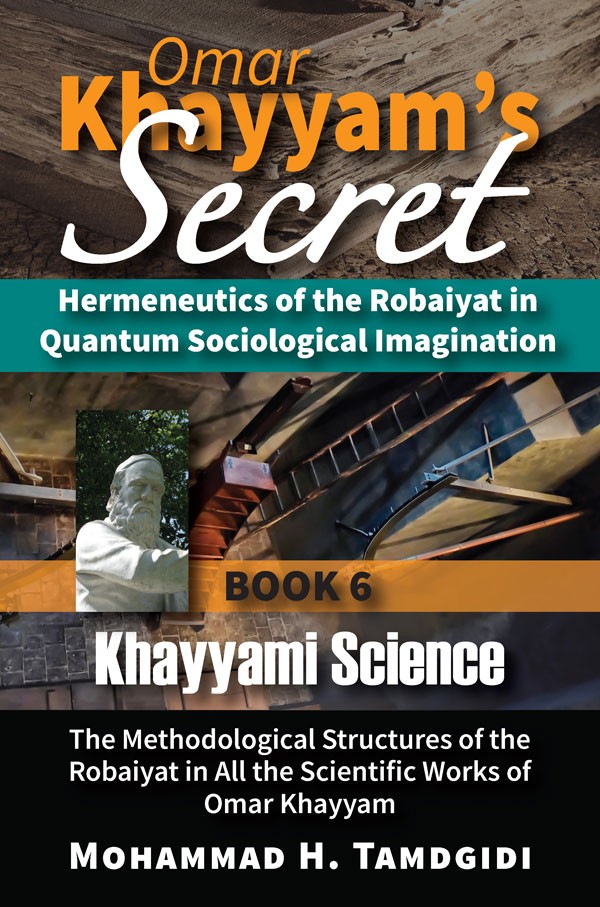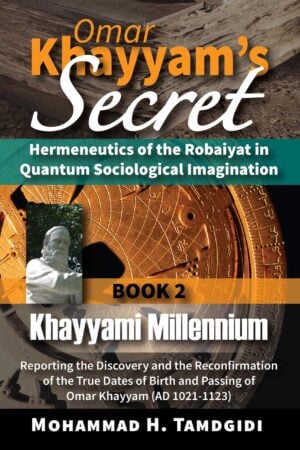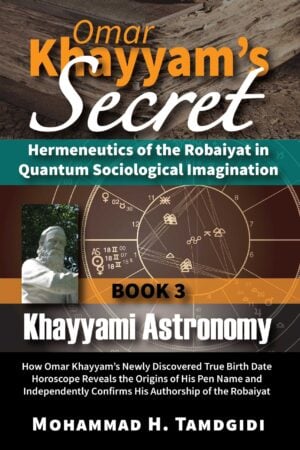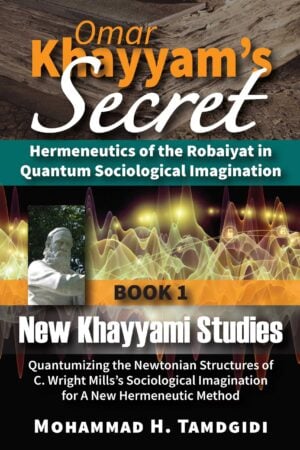Book Section: CHAPTER I—Omar Khayyam’s Treatise in Music on Tetrachords: The Arabic Text and New Persian and English Translations, Followed by Textual Analysis — by Mohammad H. Tamdgidi
$20.00
This essay titled “Omar Khayyam’s Treatise in Music on Tetrachords: The Arabic Text and New Persian and English Translations, Followed by Textual Analysis” is the first chapter of the book Khayyami Science: The Methodological Structures of the Robaiyat in All the Scientific Works of Omar Khayyam, which is the sixth volume of the twelve-book series Omar Khayyam’s Secret: Hermeneutics of the Robaiyat in Quantum Sociological Imagination, authored by Mohammad H. Tamdgidi.
Description
Abstract
This essay titled “Omar Khayyam’s Treatise in Music on Tetrachords: The Arabic Text and New Persian and English Translations, Followed by Textual Analysis” is the first chapter of the book Khayyami Science: The Methodological Structures of the Robaiyat in All the Scientific Works of Omar Khayyam, which is the sixth volume of the twelve-book series Omar Khayyam’s Secret: Hermeneutics of the Robaiyat in Quantum Sociological Imagination, authored by Mohammad H. Tamdgidi.
Book 6 of the series starts in this chapter with the examination of Omar Khayyam’s extant treatise in music on tetrachords and their types. The only handwritten Arabic manuscript of Omar Khayyam’s treatise was found in a library in Manisa, Turkey (papers 97-99), as part 8 of a collection numbered 1705. It is titled “القول على اجناس الذى بالاربعة” (al-Qowl ʾAlâ Ájnās al-Laz̧i bel-Árbaʾaẗ) (A Commentary on the Tetrachord Genera), and is attributed as “من كلام الفيلسوف عمر الخيامى” (From the Words of the Philosopher Omar al-Khayyami).
Tamdgidi’s purpose in studying Khayyam’s scientific texts in this volume, including and starting with his treatise in music, is not evaluative but hermeneutic. He wishes to understand the structures of Khayyam’s thinking and his method of analyzing his subject matter when dealing with scientific topics, hoping that the effort will offer deeper insights about how such thinking and methodological orientation can shed light on why and how Khayyam went about composing his poetry.
The author offers new Persian and English translations of the text including corrected numbers—having benefitted from Barontini and Tonietti’s (2010) effort and those of other Persian translations—because he found that further clarifications needed to be made regarding how Khayyam states the tetrachord genera types and evaluates them. The notes about corrections needed for numbers given in the Arabic texts become clear when the author explains them in footnotes and also when analyzing the text in the last section of this chapter. Important is to note that both the Arabic as well as the new Persian and English translations of this treatise included in this chapter are corrected editions, where Tamdgidi has provided the rationale for the corrections in footnotes, rather than confusing the text itself by giving both the mistaken and corrected numbers.
The author applies Khayyam’s own proposed method of going about exploring a subject—a method Khayyam outlined in his philosophical and theological treatise “Resalat fi al-Kown wa al-Taklif” (“Treatise on the Created World and Worship Duty”)—to exploring Khayyam’s scientific texts in this volume, beginning with his treatise in music on tetrachords in this chapter.
While it cannot be absolutely ruled out that Khayyam’s treatise on tetrachords, given its common subject matter (music, generally speaking), could have been somehow related to his other still non-extant treatise in music, Tamdgidi argues that the text of Khayyam’s treatise on tetrachords clearly does not indicate that it is a fragment of another writing. In his view, it is more likely that this treatise on tetrachords was a stand alone writing, a report of his own personal musical experiments, so to speak. Some indications point to the possibility that it was one of his early writings in general, and on music in particular, before the longer non-extant music he later reports to have written. This also partly explains why Tamdgidi chose to begin examining Khayyam’s scientific writings with his brief treatise on tetrachords, aiming to study the works to gain a developmental sense of how his scientific studies evolved in his lifetime. However, the author also notes other reasons that may point to the date of writing of Khayyam’s treatise as having been later in his life. In any case, the fact that Khayyam’s treatise on tetrachords is a stand alone treatise cannot be doubted.
In the treatise, Khayyam is relaying from the ancient and recent sources (not, in his own view, newly discovering) a classification system of tetrachords following the 4/3 ratio. He is stating that such tetrachords have been held to be comprised of three genera, depending on the ratio size of the intervals across the four notes. If in a tetrachord there is an interval ratio that is greater than the ratio of each of the two other intervals but is less than the sum of the ratios of the other two intervals, it is called a strong or resonant, or also known as diatonic, tetrachord. If in a tetrachord there is an interval whose ratio is greater than the sum of the ratios of the two other intervals but is not as great as twice their sum, it is a colorful or moderate, or also known as chromatic, tetrachord. If in a tetrachord there is an interval whose ratio is greater than twice the sum of the ratios of the other two intervals, it is a weak or compound, or also known as enharmonic, tetrachord.
Regarding why Khayyam wrote this treatise, Tamdgidi suggests that apart from an interest Khayyam seems have had practically in music perhaps to accompany his poetry projects, Khayyam’s treatise is telling of his deeper scientific interest in “real” geometrically representable meaning of numbers, ratios, and proportions. As brief and seemingly distant (from writing poetry) Khayyam’s treatise on tetrachords dealing with subtleties of ratios and proportionality may be, it actually can lead us to an important insight when considering any poetry Khayyam may have written. A quatrain’s meaning may be completely missed, for example, if it is taken out of the whole of a collection in which it is embedded. The relational context of Khayyam’s poems, not only in terms of their place in his life’s context, but in relation to one another as part of a logically organized collection of which they may have been a part, is something to which we will need to pay careful attention when we arrive at a point in our series when we examine the attributed Robaiyat directly.
Khayyam’s treatise in music on tetrachords provides us with an illustrative sense of Khayyam’s views on music and the discussion of ratios and proportionality, a sense that can prove helpful when we later study his treatise on Euclid and try to understand the passages therein referring to his prior study of music and its relation to Euclid’s work. The treatise gives us an applied sense of the way in which Khayyam discussed ratios and proportionality beyond their numerical treatments, insisting that we should always keep in mind the real meaning of such numbers. Khayyam clearly offers in this brief work on music an aesthetic and evaluative appreciation of ratios and proportionality in terms of the sounds associated with the ratios, one that can give us a concrete sense of how he distinguished the symbolic treatment of numbers from the experiential, geometrically representable, understanding of them in reality.
Recommended Citation
Tamdgidi, Mohammad H. 2023. “CHAPTER I—Omar Khayyam’s Treatise in Music on Tetrachords: The Arabic Text and New Persian and English Translations, Followed by Textual Analysis.” Pp. 19-60 in Omar Khayyam’s Secret: Hermeneutics of the Robaiyat in Quantum Sociological Imagination: Book 6: Khayyami Science: The Methodological Structures of the Robaiyat in All the Scientific Works of Omar Khayyam. (Human Architecture: Journal of the Sociology of Self-Knowledge: Vol. XIX, 2023. Tayyebeh Series in East-West Research and Translation.) Belmont, MA: Okcir Press.
Where to Purchase Complete Book: The various editions of the volume of which this Book Section is a part can be ordered from the Okcir Store and all major online bookstores worldwide (such as Amazon, Barnes&Noble, Google Play, and others).
Read the Above Publication Online
To read the above publication online, you need to be logged in as an OKCIR Library member with a valid access. In that case just click on the large PDF icon below to access the publication. Make sure you refresh your browser page after logging in.







